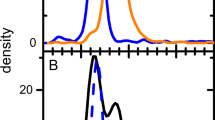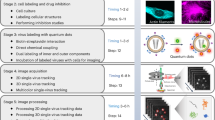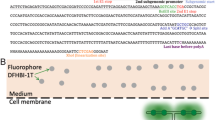Abstract
Current technologies for visualizing infectious pathways of viruses rely on fluorescent labeling of capsid proteins by chemical conjugation or genetic manipulation. For noninvasive in vivo imaging of such agents in mammalian tissue, we engineered bioluminescent Gaussia luciferase-tagged Adeno-associated viral (gLuc/AAV) vectors. The enzyme was incorporated into recombinant AAV serotypes 1, 2 and 8 capsids by fusing to the N-terminus of the VP2 capsid subunit to yield bioluminescent virion shells. The gLuc/AAV vectors were used to quantify kinetics of cell-surface-binding by AAV2 capsids in vitro. Bioluminescent virion shells displayed an exponential decrease in luminescent signal following cellular uptake in vitro. A similar trend was observed following intramuscular injection in vivo, although the rate of decline in bioluminescent signal varied markedly between AAV serotypes. gLuc/AAV1 and gLuc/AAV8 vectors displayed rapid decrease in bioluminescent signal to background levels within 30 min, whereas the signal from gLuc/AAV2 vectors persisted for over 2 h. Bioluminescent virion shells might be particularly useful in quantifying dynamics of viral vector uptake in cells and peripheral tissues in live animals.
This is a preview of subscription content, access via your institution
Access options
Subscribe to this journal
Receive 12 print issues and online access
$259.00 per year
only $21.58 per issue
Buy this article
- Purchase on Springer Link
- Instant access to full article PDF
Prices may be subject to local taxes which are calculated during checkout




Similar content being viewed by others
References
Wu Z, Asokan A, Samulski RJ . Adeno-associated virus serotypes: vector toolkit for human gene therapy. Mol Ther 2006; 14: 316–327.
Warrington Jr KH, Gorbatyuk OS, Harrison JK, Opie SR, Zolotukhin S, Muzyczka N . Adeno-associated virus type 2 VP2 capsid protein is nonessential and can tolerate large peptide insertions at its N terminus. J Virol 2004; 78: 6595–6609.
Lux K, Goerlitz N, Schlemminger S, Perabo L, Goldnau D, Endell J et al. Green fluorescent protein-tagged adeno-associated virus particles allow the study of cytosolic and nuclear trafficking. J Virol 2005; 79: 11776–11787.
Swenson ES, Price JG, Brazelton T, Krause DS . Limitations of green fluorescent protein as a cell lineage marker. Stem Cells 2007; 25: 2593–2600.
Tam JM, Upadhyay R, Pittet MJ, Weissleder R, Mahmood U . Improved in vivo whole-animal detection limits of green fluorescent protein-expressing tumor lines by spectral fluorescence imaging. Mol Imaging 2007; 6: 269–276.
Yaghoubi SS, Berger F, Gambhir SS . Studying the biodistribution of positron emission tomography reporter probes in mice. Nat Protoc 2007; 2: 1752–1755.
Piwnica-Worms D, Schuster DP, Garbow JR . Molecular imaging of host–pathogen interactions in intact small animals. Cell Microbiol 2004; 6: 319–331.
Rose JA, Maizel Jr JV, Inman JK, Shatkin AJ . Structural proteins of adenovirus-associated viruses. J Virol 1971; 8: 766–770.
Verhaegent M, Christopoulos TK . Recombinant Gaussia luciferase. Overexpression, purification, and analytical application of a bioluminescent reporter for DNA hybridization. Anal Chem 2002; 74: 4378–4385.
Tannous BA, Kim DE, Fernandez JL, Weissleder R, Breakefield XO . Codon-optimized Gaussia luciferase cDNA for mammalian gene expression in culture and in vivo. Mol Ther 2005; 11: 435–443.
Grieger JC, Samulski RJ . Packaging capacity of adeno-associated virus serotypes: impact of larger genomes on infectivity and postentry steps. J Virol 2005; 79: 9933–9944.
Grieger JC, Choi VW, Samulski RJ . Production and characterization of adeno-associated viral vectors. Nat Protoc 2006; 1: 1412–1428.
Negishi A, Chen J, McCarty DM, Samulski RJ, Liu J, Superfine R . Analysis of the interaction between AAV and heparan sulfate using atomic force microscopy. Glycobiology 2004; 14: 969–977.
Summerford C, Samulski RJ . Membrane-associated heparan sulfate proteoglycan is a receptor for adeno-associated virus type 2 virions. J Virol 1998; 72: 1438–1445.
Kolokoltsov AA, Davey RA . Rapid and sensitive detection of retrovirus entry by using a novel luciferase-based content-mixing assay. J Virol 2004; 78: 5124–5132.
Hauck B, Xiao W . Characterization of tissue tropism determinants of adeno-associated virus type 1. J Virol 2003; 77: 2768–2774.
Rabinowitz JE, Rolling F, Li C, Conrath H, Xiao W, Xiao X et al. Cross-packaging of a single adeno-associated virus (AAV) type 2 vector genome into multiple AAV serotypes enables transduction with broad specificity. J Virol 2002; 76: 791–801.
Wang Z, Zhu T, Qiao C, Zhou L, Wang B, Zhang J et al. Adeno-associated virus serotype 8 efficiently delivers genes to muscle and heart. Nat Biotechnol 2005; 23: 321–328.
Rabinowitz JE, Bowles DE, Faust SM, Ledford JG, Cunningham SE, Samulski RJ . Cross-dressing the virion: the transcapsidation of AAV serotypes functionally defines subgroups. J Virol 2004; 78: 4421–4432.
Pruchnic R, Cao B, Peterson ZQ, Xiao X, Li J, Samulski RJ et al. The use of adeno-associated virus to circumvent the maturation-dependent viral transduction of muscle fibers. Hum Gene Ther 2000; 11: 521–536.
Burger C, Gorbatyuk OS, Velardo MJ, Peden CS, Williams P, Zolotukhin S et al. Recombinant AAV viral vectors pseudotyped with viral capsids from serotypes 1, 2, and 5 display differential efficiency and cell tropism after delivery to different regions of the central nervous system. Mol Ther 2004; 10: 302–317.
Taymans JM, Vandenberghe LH, Haute CV, Thiry I, Deroose CM, Mortelmans L et al. Comparative analysis of adeno-associated viral vector serotypes 1, 2, 5, 7, and 8 in mouse brain. Hum Gene Ther 2007; 18: 195–206.
Di Pasquale G, Chiorini JA . AAV transcytosis through barrier epithelia and endothelium. Mol Ther 2006; 13: 506–516.
Matthews QL, Sibley DA, Wu H, Li J, Stoff-Khalili MA, Waehler R et al. Genetic incorporation of a herpes simplex virus type 1 thymidine kinase and firefly luciferase fusion into the adenovirus protein IX for functional display on the virion. Mol Imaging 2006; 5: 510–519.
Acknowledgements
We thank Drs Nick Muzyczka and Ken Warrington (University of Florida) for the plasmid pVp2AGFP. This work was supported by the NIH (P01HL051818, R01AI072176 and R21AR055712; RJS) and the American Heart Association (AA).
Author information
Authors and Affiliations
Corresponding author
Rights and permissions
About this article
Cite this article
Asokan, A., Johnson, J., Li, C. et al. Bioluminescent virion shells: new tools for quantitation of AAV vector dynamics in cells and live animals. Gene Ther 15, 1618–1622 (2008). https://doi.org/10.1038/gt.2008.127
Received:
Revised:
Accepted:
Published:
Issue Date:
DOI: https://doi.org/10.1038/gt.2008.127
Keywords
This article is cited by
-
Off-target-free gene delivery by affinity-purified receptor-targeted viral vectors
Nature Communications (2015)
-
Displaying High-affinity Ligands on Adeno-associated Viral Vectors Enables Tumor Cell-specific and Safe Gene Transfer
Molecular Therapy (2013)
-
Random Insertion of mCherry Into VP3 Domain of Adeno-associated Virus Yields Fluorescent Capsids With no Loss of Infectivity
Molecular Therapy - Nucleic Acids (2012)
-
A reporter system for assaying influenza virus RNP functionality based on secreted Gaussia luciferase activity
Virology Journal (2011)



